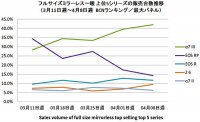I'm sorry, what? You know of pros that have switched from their 1dx2's to Alphas? Do tell. Pretty sure you'll say you do, because this is the internet and anyone can say anything. In reality, we all know deep inside you don't, because pros aren't so stupid to believe all the internet propaganda spewed from Sony forums and DPR.
At the end of the day, it doesn't matter all this talk about discounts, specs, 1-month sales figures (really?), etc. What matters is Canon and Nikon have bitten the bullet and started with fresh mounts, R and Z, respectively. In contrast, Sony made the fatal, catastrophic mistake of going with the apsc E mount for their FF alpha cameras - 6 years in, they are still trying to match EF lenses, and the ones they come out with, are just as large as EF lenses and more expensive. Pity the fool who got the "value" a73, only to find out what a mess it becomes attaching any lens worth a spit, both with ergonomics and cost ($2600 for a Sony 70-200 f/2.8, really?). Nothing short of an optical quantum breakthrough can change that. All because Sony took the shortcut and went E mount.
Now look at the Canon R and R mount. In its first year alone, it has introduced useful new technology, including the control ring, drop-in filter adapters, shutter closing to prevent sensor dust, and virtually unlimited focus points. Add to that best-in-class fully articulating touchscreen, best-in-class EVF, best-in-class touchpad (who needs the joystick?), best-in-class low light focusing, best-in-class focus speed and accuracy, best-in-class video bitrate and grading, and yes, the best color science and ergonomics (of course), the 1st-gen hits the ground running (I'm not the only one who feels that way:
https://alikgriffin.com/canon-eos-r-just-about-everyone-got-it-wrong ). Now add the fresh R mount, allowing groundbreaking lenses like the 28-70 f/2. Yes it's heavy and expensive, but only consumers complain about that - pros can see the value of not needing 2 or 3 dedicated primes. The upcoming RF f/2.8 zooms will rock too, offering again groundbreaking designs.
Yes eye-tracking could improve, and dual-card slots and IBIS will need to come and it will, but the foundation laid down by Canon is rock solid. Watch, just watch, Sony's market share, not on a 1 month basis, but watch it in 6 months, then 1 year, then a few. If it grows, it will not be at Canon's expense.

